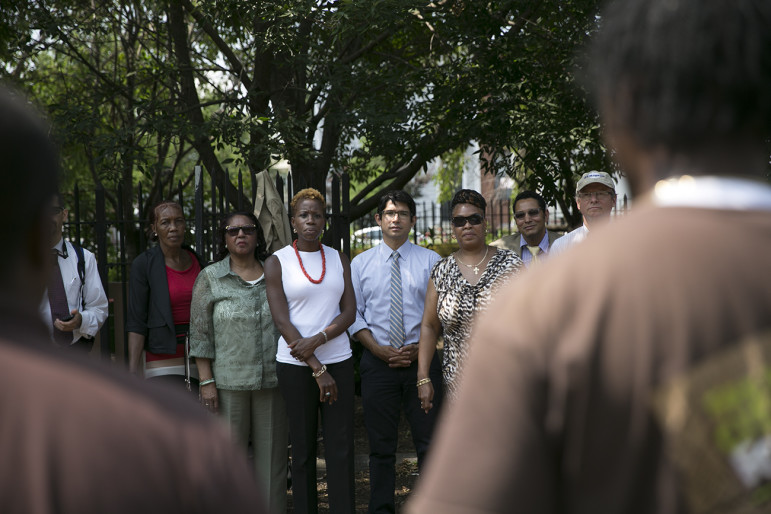
William Alatriste for the New York City Council
NYCHA chairwoman Shola Olatoye, in white shirt, at a 2014 outreach event in Brooklyn. Her fans credit her with being more accessible, but there have been limits on public engagement's impact on NYCHA policy.
On a frigid Saturday last January, Shola Olatoye came out to speak with New York City Housing Authority residents about her plan to save their homes. She had less than a year earlier been appointed leader of NYCHA, the nation’s oldest and largest public-housing system, and been given a daunting task: to bring the authority, which houses half a million New Yorkers, back from the brink of extinction.
Olatoye (pronounced oh-LAH-toy-ay) was supposed to brief the presidents of about 100 of the Tenant Associations that represent each NYCHA development about her evolving plan to rescue the authority, called NextGeneration NYCHA.
But first, they briefed her. The pump had gone out at the Wykoff Gardens Development and there was no water. The roof of the Warren Street Houses needed to be fixed. There was mold in many of the apartments, plus there was raw sewage leaking into the first floor apartments. At multiple developments, there had been no heat, sometimes for days on end, despite the cold weather. And the elevator in Reid Houses was broken. Tenant Association President Aida Thomas had to carry her walker down the stairs. “The conditions in the building are terrible,” Thomas lamented.
These complaints were all too familiar. The federal government had been steadily decreasing funding to public housing, leaving NYCHA with a $40 million annual shortfall in operating costs, as well as a $17 billion backlog of capital repairs to its roofs, elevators, heating systems, apartments and grounds. The threat to NYCHA had grown ever more intense, ever more dire, with no signs of abatement. It was enough to shake residents’ faith in the competence, some would say even the character, of the people running NYCHA. So it was a skeptical crowd Olatoye stood before on that Saturday morning.
But the chair was eloquent, clear, and firm. She was hopeful but realistic, addressing the resident leaders—many of whom she knew by name—with respect. “It’s a humbling experience to lead the country’s largest housing authority,” she said. “It’s also a tremendous honor.” She called herself a NYCHA “granddaughter,” because her grandmother lived in Albany Houses. “We have to operate like any other landlord,” Olatoye went on emphatically. “You all have the exact same rights as I do in my building.”
She also didn’t shy away from harsh truths; the NextGeneration plan, for instance, included a plan for the authority to get better at collecting rent, which wasn’t going to be happy news for every tenant. But Olatoye cut an impressive figure, and had brought with her an entourage of employees who took down complaints from the Tenant Association presidents. After she spoke, the energy in the room shifted dramatically.
“A lot of my questions were answered,” Thomas said. “I have seen a change, so I’m hopeful on that.” Thomas compared Olatoye favorably to her predecessor, John Rhea, Mayor Bloomberg’s final NYCHA chair. “There’s no comparison,” Thomas said. “He never even came out.”
If there’s one thing Shola Olatoye does, it’s come out. She told the Tenant Association presidents that the mayor had actually charged her with two tasks when he appointed her—with achieving financial solvency for the failing Authority and also “reigniting the relationship between NYCHA and its key stakeholders—you.”
Neither mission will be easy, and dong them both might be impossible. In Bill de Blasio’s ambitious and so-far star-crossed effort to create a city that has less inequality and more citizen engagement, NYCHA—a Big Government program that successfully defended decent living for people of limited means for decades and now faces existential threats—is the ultimate test flight. And Shola Olatoye is its pilot.
Olatoye, who did not agree to be interviewed for this piece, grew up in Waterbury, Conn., a town that experienced a significant economic decline in the 1970s and 1980s. By 1992, Waterbury was ranked last out of 300 U.S. metropolitan areas in terms of quality of life by Money magazine, due in no small part to dying industry and a crumbling infrastructure.
Olatoye told the Wall Street Journal that she grew up in a very religious, single-mother household. She was originally named “Oyeshola”, a unisex name meaning “God’s gracious gift” in Yoruba, a language spoken in Nigeria where her father is from. Her mother shortened it to Shola, easier for the American tongue.
Olatoye’s understanding of the challenges of housing began early. She told the Wall Street Journal that she regularly took the bus with her mother to visit her grandmother in the Albany Houses in East New York. When she was 10, her mother enrolled in a program in Waterbury designed to help first-time homebuyers. Olatoye told Crains that this program fundamentally changed the course of her life.
According to her Facebook page, Olatoye attended Crosby High School, where she was a sprinter, and to this day, she runs in the wee hours of the morning. She went on to Wesleyan University, which she attended from 1992 to 1996 (arriving just five years after her predecessor at NYCHA, Rhea, graduated). There she studied history and African-American studies. According to a friend who knew her then, she was deeply motivated; Olatoye inspired awe in and deference from her fellow classmates, and already displayed a strong commitment to public service. It was in college that she met her husband, Matthew Strozier, an editor at Dow Jones. The couple now lives in Harlem with their three children.
Olatoye thought she would become a professor. But after college, she spent four years in New York working in education policy and reform, where her capacity to listen to those she hoped to serve was strongly on display. In 1998, she directed a survey for the Campaign for Fiscal Equity, a nonprofit coalition of parents, community school boards, and advocacy groups. “This survey is a chance for teachers, parents and principals to tell us what is missing, and what they need to be able to provide all children with a sound basic education,” Olatoye told the Daily News at the time. The campaign met with thousands of parents, teachers, and administrations over the course of two years.
But education policy wasn’t for her, for reasons that, given her current position, seem almost impossibly ironic in hindsight. “I quickly got burned out by the argument of ‘We need more money, there’s not enough money, we need more money, there’s not enough money,'” she said at a forum at NYU’s Wagner School of Public Policy in 2012.
So Olatoye decided to go to graduate school, believing that it would provide her with “a broader prism with which to think about complex public policy issues.” From 1999 to 2001 she studied public policy at Wagner. That led to a job as issues director for Mark Green’s 2001 mayoral campaign.
Green remembers Olatoye as unflappable, steady, and thorough. “She was a delightful combination of smarts and charm,” he recalled recently. “In a mayor’s campaign there’s a lot of pressure to produce a volume of work quickly, and she did.”
After the election, Olatoye went to work for a consulting firm that “really plays at the intersection of the public and the private,” as she recalled. She spent six years as a Director of HR&A Advisors, Inc., a real-estate and economic development consulting firm, and then worked in community development lending for HSBC. In that work she was drawn, she said at the Wagner forum, to neighborhoods that presented a real-estate challenge—a distressed neighborhood, a downtown with vacancies, a community boasting a strong university but beset by decay.
In 2007, while Olatoye was at HSBC, the couple moved to South Florida and bought a condo. During her time in the Sunshine State Olatoye’s public profile was far lower than now, but her name does surface in news archives in the form of a brief critique she penned about an article by Matt Bai in the New York Times entitled “Is Obama the End of Black Politics?”
“Where were the women in Matt Bai’s piece?” Olayote wrote. “How could Bai purport to talk about the generational shift within the black ‘body politic’ and not talk about the increasing (or simply long-ignored) presence of black women? Do the mayors of Atlanta and Baltimore, who happen to be women, have something to add to this conversation? If something like half the black men between the ages of 18 and 34 are in jail or felons, just who is electing some of these black leaders?” (This vein of Olatoye’s public persona emerged again in March when she told First Lady Chirlane McCray that her female role model is Shirley Chisholm, the first African American woman elected to Congress, who was also the first major-party black candidate for president as well as the first woman to run for the Democratic presidential nomination.)
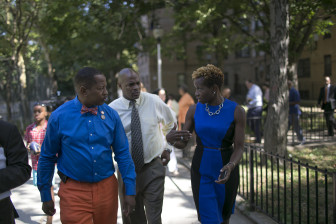
William Alatriste for the New York City Council
Bronx Councilmember Andrew King tours a NYCHA development with authority chairwoman Shola Olatoye.
In 2010, Olatoye and her family were back in New York and Olatoye began working for Enterprise Community Partners, a company that provides development capital for affordable housing, as director of relationship management in New York. She climbed the ranks quickly, and was named New York Market Leader in 2012, at the age of 37. Her new post meant she was in charge of 50 people, “working with community partners, the public sector and private capital sources to build and preserve approximately 3,000 affordable homes per year.”
“She was able to inspire people and back that up with tangible results,” recalls Terri Ludwig, president and CEO of Enterprise. Ludwig remembers Olatoye as someone with a deep understanding of systemic change, able to navigate complex issues as well as on-the-ground needs—a duality that shone through in Olatoye’s Hurricane Sandy relief efforts. “She showed up in the face of disaster and brought together key stakeholders,” Ludwig recalls. “She really was willing to make sacrifices, bringing her whole self.”
It was in her capacity as vice president and New York market leader of Enterprise that Olatoye’s path crossed that of then-NYCHA boss Rhea over a new mixed-use development at NYCHA’s Washington Houses (Enterprise was syndicating the tax credits). In just 10 months, she would have Rhea’s job.
From the beginning of de Blasio’s hiring process, Olatoye’s name came up in speculation and recommendation. “The Democrat is mindful not to be seen as measuring the drapes at Gracie Mansion, as Mark Green seemed to do before losing the 2001 election to Michael Bloomberg,” reported Crain’s in November of 2013. Nevertheless, Crain’s predicted that Olatoye was one of two people being considered to lead the Department of Housing Preservation and Development. Instead, the mayor announced in early February 2013 that Olatoye would lead the struggling housing authority.
“Ms. Olatoye, married with two sons, will likely have to take a salary cut from her current annual pay of $242,000 at Enterprise Community Partners, as the current NYCHA chair salary is $210,000,” remarked one paper covering her appointment. “However, her new job comes with a car and driver.”
Overnight, Olatoye went from managing 50 people to managing 11,000.
With her unique combination of skills, Olatoye may be the perfect person to save NYCHA. A woman of color with a combination of personal magnetism, intelligence, housing experience and political and media savvy, she leads an agency that sits at the confluence of all the currents shaping the city these days—displacement vs. permanence, old-fashioned institutions against the new reality of inequality, federal neglect and local need. As a talented black woman in an interracial marriage living in a rapidly gentrifying neighborhood, Olatoye is an embodiment of a new kind of New York City political profile.
From the beginning of her tenure at NYCHA, Olatoye impressed residents with her sincere desire to engage with them. She visited over 90 developments in the first year of her tenure, during much of which she was pregnant with her third child. She impressed Aixa Torres, a powerful tenant leader from Smith Houses on the Lower East Side, when Olatoye brought her own children to NYCHA family day.
Many draw a distinction between her and her predecessor. “There’s a huge difference between Chairman Olatoye and Mayor de Blasio, and John Rhea and the Bloomberg Administration, partly being as soon as Shola came into office she started meeting with a lot of the resident associations,” says Jonathan Gardenhire, a resident leader of Smith Houses. “She’s obviously more charismatic and passionate about the future of public housing in New York and so is the mayor and that’s something the city hasn’t seen in a while.”
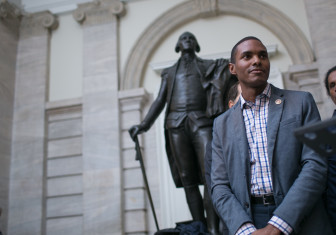
William Alatriste for the New York City Council
Read part 2 of this series: Bronx progressive Ritchie Torres embraces controversial ideas for shoring up NYCHA.
“It makes me feel really good, that she’s reaching out, she’s trying this new idea with Next Generation NYCHA, totally different, engaging residents a lot more,” John Johnson, TA president of Mott Haven and CCOP South Bronx District chair, told me in February. According to HUD’s 964 regulations, residents are supposed to be involved in the decision-making process at all levels. “Shola Olatoye is leaning more towards that.”
This recommitment to the 964 regulations was perhaps most on display during the rollout of NextGeneration NYCHA, the authority’s roadmap to financial stability, which Olatoye insists includes the feedback of residents, culled from the many visits she made to different developments.
“NextGeneration NYCHA is a process and a plan,” she told City Limits before the rollout. “It’s a process that values transparency and listening, that values inclusiveness—of residents, employees, community stakeholders, and elected officials.”
But while earnest and extensive, the current administration’s engagement efforts were still limited. Vic Bach, senior housing analyst for Community Service Society, questions how effective the recent visioning sessions were. The residents who attended those sessions had clear priorities: They wanted repairs done. “And those priorities were never really satisfied,” says Bach. “But NYCHA did push through its development plan.”
Indeed, as City Limits reported, the Tenant Association presidents at the three developments first targeted for new affordable housing development all dispute their purported role in the visioning process. “We’re totally against the affordable housing unless it’s 100 percent for us and we have that in ironclad writing,” Anthony Sosa, TA president of Ingersoll, told me. Lisa Kenner, TA president of Van Dyke, went ever further. “They came in here tricking people,” she told me. (“We’ve not just listened to the loudest person in the room,” Olatoye told City Limits when asked about residents opposing development).
Gardenhire feels that the NextGeneration plan was delivered as a fait accompli. “They should have approached the communities and seen what their needs are,” he said, rather than swooping in with a preconceived plan.
Others say that NYCHA remains a deeply secretive agency, a complaint that arose early in 2015 when Olatoye inked with no fanfare a plan to sell a stake in six Section 8 buildings to a consortium involving a private company. It was done to get much-needed repairs underway at those buildings and to improve NYCHA’s dismal balance sheet. But at a February oversight hearing, City Councilmember Laurie Cumbo expressed shock that the Council was hearing about the plan in the past tense. “So this is done?” she asked Olatoye incredulously. The answer was yes. Manhattan Borough President Gale Brewer called it “an important lapse.” The overall lack of transparency “should never, never be repeated,” Brewer said.
In other words, Olatoye’s considerable personal magnetism hasn’t cured the deep doubts eating away at her agency. A year into her term, the Daily News ran a story exposing the Housing Authority for quietly selling off hundreds of thousands of dollars of brand-new, unused items for pennies on the dollar.
Then, in June, members of the Metro Industrial Areas Foundation called for Olatoye’s ouster.
“Yes, [the mayor] appointed a smart, decent chairperson, Ms. Shola Olatoye,” Reverend David Brawley, pastor of St. Paul’s Baptist Church in Brooklyn, said at the IAF presser. “But then, he failed to offer the money and the support she needed to be successful.” Olatoye has been “respectful” and “accessible,” Brawley said, “but that’s not been enough to get the mold out of our apartments.” Metro IAF contends, and a judge has concurred, that NYCHA is failing to live up to promises it made in a 2014 court settlement over mold remediation.
Olatoye did not respond directly to the calls for her to step down. Brawley and others involved in the Metro IAF action made it clear that they were calling for her head merely to get to the mayor, whom they see as aloof when it comes to NYCHA.
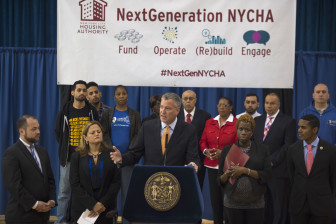
Demetrius Freeman/Mayoral Photography Office.
Olatoye flanks Mayor de Blasio at the rollout of NextGeneration NYCHA in May.
This is the problem for Olatoye. For all her commitment and skill, despite her early success at winning some tenant leaders over, NYCHA’s fate depends on other people. One is the mayor, who early on stopped letting the city leech off NYCHA’s budget but still faces criticism over maintenance problems. Another is the governor, who offered, then basically withdrew, $100 million in capital support to the authority this year. The biggest and most neglectful player is the federal government, which has shortchanged public housing around the country for a generation. And now the private sector, involved in financing several NYCHA projects, is at the table as well.
Still, under Olatoye’s leadership, NYCHA has changed for the better, says Judith Goldiner, attorney-in-charge of the Legal Aid Society’s civil law reform unit. She gives Olatoye credit for leading a more transparent NYCHA and taking on the huge task of trying to save public housing. “She is very committed, and she’s brought on people who care deeply about that goal. I think she’s working hard to make that happen.”
“What Shola Olatoye is bringing to this is both philosophical and pragmatic: We have to involve the tenants,” said Holly Leicht, regional administrator of the U.S. Department of Housing and Urban Development (HUD), which oversees NYCHA. “This is a chair who really gets it from all angles, that this is a critical moment to try to pursue these more innovative things. She has the credibility of being really honest with all parties. She’s that person.”
Indeed, perhaps the most important task facing Olatoye is neither the financial viability that might just barely be attainable, nor the engagement with residents which, as NextGen showed, can only go so far, but rather, flipping the script on public housing and reinstating the authority’s credibility. Rather than a magnet for residential, political and journalistic barbs and despair, as it was during the previous administration, NYCHA must become an institution with glimmers of hope, an already existing source of affordable housing worth reinvestment from the city, state, and federal government. The question is, can she do it?
Those who know her think she can. One way or another, what Ludwig from Enterprise Community Partners, told City Limits is undeniably true: “She’s just getting started.”
Correction: The initial version of this story incorrectly reported that Olatoye is the first woman to head NYCHA. At least two of her predecessors were women: Laura Blackburne and Sally Hernandez-Pinero oversaw the Authority in the early 1990s.
City Limits’ coverage of public housing is supported by the Charles H. Revson Foundation.


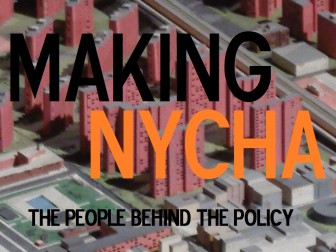
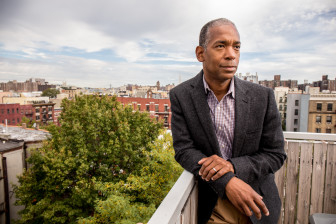







2 thoughts on “In Mayor’s Fight Against Inequality, NYCHA Chair Faces Toughest Battle”
NYCHA freeloaders. In 255 of the 352 (72.6%) NYCHA buildings the tenants get taxpayer-paid electricity.
https://files.acrobat.com/a/preview/28684695-0de4-4700-b643-b6502588d2cc
NYCHA and the new chairperson “Shola” have no intention to give housing to anyone who is low income or poor. The big push is still gentrification, as NYCHA housing is allowed to decay without a protest from “Shola.” In the Bronx with the rezoning plan for Jerome Avenue, it all came out at the
Bronx Gentrification forum on Sunday. They want to destroy all the auto
shops and machine tool businesses, and
then they will not even have the money to build anything…. and if
they did, 80/20 is a joke. Even the 20% have to make $69,000 a year. The
speculators want their real estate because under Dodd-Frank banking
law, the bail-in is when the depositors’ money is confiscated. We must have the new Glass Steagall Act a la Franklin Roosevelt of 1933 now, a bankruptcy
reorganization protection of people and business. Otherwise we will
have mass death, mass homelessness, a horror show. Larouchepac and http://www.larouchepac.com have been right. Otherwise even nice people like Shola turn into Nazi-type capos.